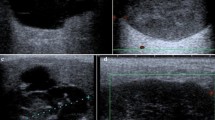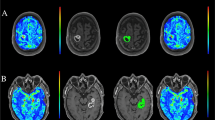Purpose:
To evaluate the use of noninvasive quantified contrast-enhanced power Doppler ultrasonography as a surrogate in the estimation of tumor hypoxia measured by invasive pO2 histography in canine tumors.
Material and Methods:
Data of pretreatment tumor oxygenation status, tumor vascularity and blood volume, and tumor response after radiation therapy was collected in 48 spontaneous malignant oral tumors (Table 1). Tumor oxygenation status was correlated to vascularity and blood volume, and influences on outcome after treatment were analyzed.
Results:
Although vascularity and blood volume correlated moderately with median pO2 (r = 0.51 and 0.61; p = 0.001 and < 0.0001) and percentage of pO2 readings ≤ 2.5, 5, and 10 mmHg (r = –0.37 to –0.42; p < 0.01–0.03) for all tumors, they did not correlate within the different histology groups (p = 0.06–0.9). For all tumors, pretreatment oxygenation status, vascularity and blood volume were not found to be of prognostic value (Tables 2 and 3).
Conclusion:
These analyses show that quantified contrast-enhanced power Doppler ultrasonography does not represent a noninvasive indirect method to assess tumor hypoxia measured by invasive pO2 histography. Both technologies were nonprognostic indicators in spontaneous malignant canine oral tumors.
Ziel:
Untersuchung des nichtinvasiven quantifizierten, kontrastverstarkten Power-Doppler-Ultraschalls als alternative Methode bei der Einschatzung der Tumorhypoxie, die in spontanen Tumoren beim Hund mittels invasiver pO2-Histographie gemessen wurde.
Material und Methodik:
Oxygenierungsstatus, Gefasdichte und Blutvolumen vor der Behandlung sowie das Tumorverhalten nach Strahlentherapie wurden bei 48 Hunden mit spontanen malignen Tumoren der Maulhohle untersucht (Tabelle 1). Der Oxygenierungsstatus wurde zur Gefasdichte und zum Blutvolumen korreliert, und Faktoren, die die Tumorantwort nach Strahlentherapie beeinflussen konnen, wurden analysiert.
Ergebnisse:
Obwohl die Gefasdichte sowie das Blutvolumen moderat mit dem Zentralwert (medianer pO2 [r = 0,51 und 0,61; p = 0,001 und < 0,0001]) und der prozentualen Verteilung der pO2-Messwerte ≤ 2,5, 5 und 10 mmHg (r = –0,37 bis –0,42; p < 0,01–0,03) fur alle Tumoren korrelierte, verlor sich diese Korrelation innerhalb der einzelnen histologischen Gruppen (p = 0,06–0,9). Uber alle Tumortypen gesehen, waren Oxygenierungsstatus, Gefasdichte und Blutvolumen, gemessen vor der Strahlentherapie, nicht von prognostischem Wert (Tabellen 2 und 3).
Schlussfolgerung:
Diese Untersuchung zeigt, dass der kontrastverstarkte Power-Doppler-Ultraschall die invasive pO2-Histographie nicht ersetzt und beide Methoden keine prognostischen Indikatoren bei spontanen Tumoren der Maulhohle des Hundes darstellen.
Similar content being viewed by others
References
Achermann R, Ohlerth S, Fidel J, et al. Ultrasound guided, pre-radiation oxygen measurements using polarographic oxygen needle electrodes in spontaneous canine soft tissue sarcomas. In Vivo 2002;16:431–437.
Achermann RE, Ohlerth SM, Rohrer Bley C, et al. Oxygenation of spontaneous canine tumors during fractionated radiation therapy. Strahlenther Onkol 2004;180:297–305.
Auer F, Röper B, Scheich D, et al. Technical improvement of pO2 measurements in breast cancer. Investigation of the feasibility in patients and in vitro validation of the method. Strahlenther Onkol 2007;183:265–270.
Bateman KE, Catton PA, Pennock PW, et al. 0-7-21 radiation therapy for the treatment of canine oral melanoma. J Vet Intern Med 1994;8:267–272.
Bergman PJ. Canine oral melanoma. Clin Tech Small Anim Pract 2007;22:55–60.
Blackwood L, Dobson JM. Radiotherapy of oral malignant melanomas in dogs. J Am Vet Med Assoc 1996;209:98–102.
Brizel DM, Scully SP, Harrelson JM, et al. Tumor oxygenation predicts for the likelihood of distant metastases in human soft tissue sarcoma. Cancer Res 1996;56:941–943.
Brizel DM, Sibley GS, Prosnitz LR, et al. Tumor hypoxia adversely affects the prognosis of carcinoma of the head and neck. Int J Radiat Oncol Biol Phys 1997;38:285–289.
Burk RL. Radiation therapy in the treatment of oral neoplasia. Vet Clin North Am Small Anim Pract 1996;26:155–163.
Ciekot PA, Powers BE, Withrow SJ, et al. Histologically low-grade, yet biologically high-grade, fibrosarcomas of the mandible and maxilla in dogs: 25 cases (1982—1991). J Am Vet Med Assoc 1994;204:610–615.
Dellas K, Bache M, Pigorsch SU, et al. Prognostic impact of HIF-1α expression in patients with definitive radiotherapy for cervical cancer. Strahlenther Onkol 2008;184:169–174.
Evans SM, Koch CJ. Prognostic significance of tumor oxygenation in humans. Cancer Lett 2003;195:1–16.
Feldmann HJ, Molls M, Vaupel P. Blood flow and oxygenation status of human tumors. Clinical investigations. Strahlenther Onkol 1999;175:1–9.
Fleischer AC, Wojcicki WE, Donnelly EF, et al. Quantified color Doppler sonography of tumor vascularity in an animal model. J Ultrasound Med 1999;18:547–551.
Gagel B, DiMartino E, Schramm O, et al. Contrast-enhanced color duplex sonography (CDS): an alternative for the evaluation of therapy-relevant tumor oxygenation? Strahlenther Onkol 2006;182:604–609.
Gagel B, Piroth M, Pinkawa M, et al. pO polarography, contrast enhanced color duplex sonography (CDS), [18F] fluoromisonidazole and [18F] fluorodeoxyglucose positron emission tomography: validated methods for the evaluation of therapy-relevant tumor oxygenation or only bricks in the puzzle of tumor hypoxia? BMC Cancer 2007;7:113.
Gagel B, Reinartz P, Dimartino E, et al. pO2 polarography versus positron emission tomography ([18F] fluoromisonidazole, [18F]-2-fluoro-2′-deoxyglucose). An appraisal of radiotherapeutically relevant hypoxia. Strahlenther Onkol 2004;180:616–622.
Harrison LB, Chadha M, Hill RJ, et al. Impact of tumor hypoxia and anemia on radiation therapy outcomes. Oncologist 2002;7:492–508.
Hökel M, Knoop C, Schlenger K, et al. Intratumoral pO2 predicts survival in advanced cancer of the uterine cervix. Radiother Oncol 1993;26:45–50.
Hökel M, Schlenger K, Knoop C, et al. Oxygenation of carcinomas of the uterine cervix: evaluation by computerized O2 tension measurements. Cancer Res 1991;51:6098–6102.
Hökel M, Schlenger K, Mitze M, et al. Hypoxia and radiation response in human tumors. Semin Radiat Oncol 1996;6:3–9.
Kappler M, Taubert H, Holzhausen HJ, et al. Immunohistochemical detection of HIF-1α and CAIX in advanced head-and-neck cancer. Prognostic role and correlation with tumor markers and tumor oxygenation parameters. Strahlenther Onkol 2008;184:393–399.
Kotas M, Schmitt P, Jakob PM, et al. Monitoring of tumor oxygenation changes in head-and-neck carcinoma patients breathing a hyperoxic hypercapnic gas mixture with a noninvasive MRI technique. Strahlenther Onkol 2009;185:19–26.
Lassau N, Lamuraglia M, Vanel D, et al. Doppler US with perfusion software and contrast medium injection in the early evaluation of isolated limb perfusion of limb sarcomas: prospective study of 49 cases. Ann Oncol 2005;16:1054–1060.
Lassau N, Mercier S, Koscielny S, et al. Prognostic value of high-frequency sonography and color Doppler sonography for the preoperative assessment of melanomas. AJR Am J Roentgenol 1999;172:457–461.
Lencioni R, Mascalchi M, Caramella D, et al. Small hepatocellular carcinoma: differentiation from adenomatous hyperplasia with color Doppler US and dynamic Gd-DTPA-enhanced MR imaging. Abdom Imaging 1996;21:41–48.
Luong RH, Baer KE, Craft DM, et al. Prognostic significance of intratumoral microvessel density in canine soft-tissue sarcomas. Vet Pathol 2006;43:622–631.
Menon C, Polin GM, Prabakaran I, et al. An integrated approach to measuring tumor oxygen status using human melanoma xenografts as a model. Cancer Res 2003;63:7232–7240.
Nordsmark M, Hoyer M, Keller J, et al. The relationship between tumor oxygenation and cell proliferation in human soft tissue sarcomas. Int J Radiat Oncol Biol Phys 1996;35:701–708.
Nordsmark M, Overgaard J. A confirmatory prognostic study on oxygenation status and loco-regional control in advanced head and neck squamous cell carcinoma treated by radiation therapy. Radiother Oncol 2000;57:39–43.
Nordsmark M, Overgaard J. Tumor hypoxia is independent of hemoglobin and prognostic for loco-regional tumor control after primary radiotherapy in advanced head and neck cancer. Acta Oncol 2004;43:396–403.
Ogura O, Takebayashi Y, Sameshima T, et al. Preoperative assessment of vascularity by color Doppler ultrasonography in human rectal carcinoma. Dis Colon Rectum 2001;44:538–46, discussion 546–8.
Ohlerth S, Wergin M, Rohrer Bley C, et al. Correlation of quantified contrast-enhanced power Doppler ultrasonography with immunofluorescent analysis of microvessel density in spontaneous canine tumours. Vet J 2008; doi: 10.1016/j.tvjl.2008.08.026.
Poirier VJ, Bley CR, Roos M, et al. Efficacy of radiation therapy for the treatment of macroscopic canine oral soft tissue sarcoma. In Vivo 2006;20:415–419.
Rades D, Golke H, Schild SE, et al. Impact of VEGF and VEGF receptor 1 (FLT1) expression on the prognosis of stage III esophageal cancer patients after radiochemotherapy. Strahlenther Onkol 2008;184:416–420.
Rohrer Bley C, Ohlerth S, Roos M, et al. Influence of pretreatment polarographically measured oxygenation levels in spontaneous canine tumors treated with radiation therapy. Strahlenther Onkol 2006;182:518–524.
Rudat V, Stadler P, Becker A, et al. Predictive value of the tumor oxygenation by means of pO2 histography in patients with advanced head and neck cancer. Strahlenther Onkol 2001;177:462–468.
Rudat V, Vanselow B, Wollensack P, et al. Repeatability and prognostic impact of the pretreatment pO2 histography in patients with advanced head and neck cancer. Radiother Oncol 2000;57:31–37.
Scholbach T, Scholbach J, Krombach GA, et al. New method of dynamic color Doppler signal quantification in metastatic lymph nodes compared to direct polarographic measurements of tissue oxygenation. Int J Cancer 2005;114:957–962.
Steel GG. The growth rate of tumours. In: Steel GG, ed. Basic clinical radiobiology. New York: Arnold, 2002:8–22.
Theon AP, Rodriguez C, Madewell BR. Analysis of prognostic factors and patterns of failure in dogs with malignant oral tumors treated with megavoltage irradiation. J Am Vet Med Assoc 1997;210:778–784.
Tschammler A, Beer M, Hahn D. Differential diagnosis of lymphadenopathy: power Doppler vs color Doppler sonography. Eur Radiol 2002;12:1794–1799.
Vaupel P, Hockel M, Mayer A. Detection and characterization of tumor hypoxia using pO2 histography. Antioxid Redox Signal 2007;9:1221–1235.
Vaupel P, Kallinowski F, Okunieff P. Blood flow, oxygen and nutrient supply, and metabolic microenvironment of human tumors: a review. Cancer Res 1989;49:6449–6465.
Vaupel P, Kelleher DK, Thews O. Modulation of tumor oxygenation. Int J Radiat Oncol Biol Phys 1998;42:843–848.
Author information
Authors and Affiliations
Corresponding author
Additional information
Both authors contributed equally to the study.
Rights and permissions
About this article
Cite this article
Rohrer Bley, C., Laluhova, D., Roos, M. et al. Correlation of Pretreatment Polarographically Measured Oxygen Pressures with Quantified Contrast-Enhanced Power Doppler Ultrasonography in Spontaneous Canine Tumors and their Impact on Outcome After Radiation Therapy. Strahlenther Onkol 185, 756–762 (2009). https://doi.org/10.1007/s00066-009-1988-6
Received:
Accepted:
Published:
Issue Date:
DOI: https://doi.org/10.1007/s00066-009-1988-6




